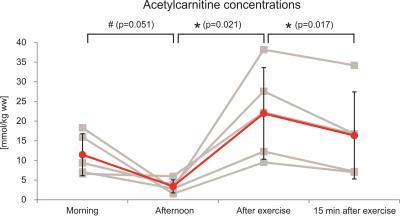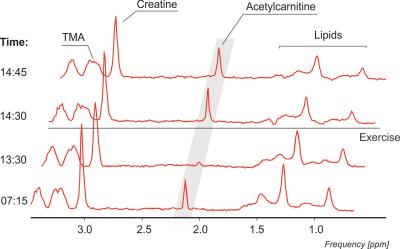4995
Diurnal changes of Acetylcarnitine in human vastus lateralis muscle and response to exercise: a 7T 1H MRS study1High-Field MR Center, Department of Biomedical Imaging and Image-Guided Therapy, Medical University of Vienna, Vienna, Austria, 2Department of NMR Spectroscopy and Mass Spectrometry, Faculty of Chemical and Food Technology, Slovak University of Technology, Bratislava, Slovakia, 3Christian Doppler Laboratory for Clinical Molecular MR Imaging, Vienna, Austria, 4University of Oxford Centre for Clinical Magnetic Resonance Research, University of Oxford, John Radcliffe Hospital, Oxford, United Kingdom, 5Department of Imaging Methods, Institute of Measurements Science, Slovak Academy of Sciences, Bratislava, Slovakia, 6Division of Endocrinology and Metabolism, Department of Medicine III, Medical University of Vienna, Vienna, Austria, 7Center of Sport Science and University Sport, University of Vienna, Vienna, Austria
Synopsis
Carnitine plays an important role in fat metabolism. A long-echo time proton magnetic resonance spectroscopy protocol was implemented for detection of skeletal muscle acetylcarnitine during the day and after exercise on a clinical 7T scanner in the thigh (vastus lateralis) muscle. Our observation point towards diurnal changes of acetylcarnitine concentration which tended to be higher in the morning than after lunch. Moreover, following 10 minutes of high-intensity exercise the concentration significantly increased and again significantly decreased 15 minutes after cessation of the exercise. Our data emphasize the need for strict standardization,physical activity and dietary conditions for the measurement of the acetylcarnitine/carnitine.
Introduction:
Skeletal muscle is the main reservoir of carnitine, which plays an important role in fat metabolism[1]since it serves as a shuttle for acetyl groups to mitochondrial matrix. Therefore,acetylcarnitine covers also a key role in glucose metabolism and is implicated in the pathogenesis of insulin resistance contributing to a diagnosis of Type 2 Diabetes[2]. Since acetylcarnitine concentrations in plasma are known to vary during the day[3] and increase after high-intensity exercise[4][5] we aimed to investigate the diurnal and exercise related changes in concentration of acetylcarnitine at 2.13ppm in skeletal muscle non-invasively, using a long echo-time 1H MRS at 7T.
Methods:
All measurements were performed on a 7T whole body Siemens MR system equipped with a 28channel knee coil from QED. Up to now, five healthy, normally active volunteers (age 29.2±1.3 years, BMI 22.8±2.5 kg/m2, self-reported activity of 1-2 training units a week mean VO2max 39.9±7.3 ml. min-1. kg-1)participated in this study. They were positioned supine in the magnet and the measurement was performed on left vastus lateralis (VL) muscle. To guide shimming and localization T1 weighted images were acquired. The MRS VOI (40 x 35 x 15 mm3) was carefully placed into the VL muscle. Localized shimming was performed manually, on the adjustment volume matching the VOI size. Data were obtained using STEAM sequence with following parameters: TR/TE=2000/350 ms; spectral bandwidth=3kHz; number of averages (NA)=128; delta frequency= -2.5 ppm relative to water resonance; 4 preparation scans. For absolute quantification determination, water signal was measured separately (TR/TE= 2000/20 ms; NA=1; delta frequency=0 ppm).
All volunteers underwent first measurement early in the morning (7 a.m.),
after overnight fast and no strenuous exercise in the morning. Second
measurement of acetylcarnitine from the same VOIs was performed
after normal hospital canteen lunch.
Subsequently,volunteers performed high intensity exercise (10 minutes of
continuous squats; n=274±38). The 1H MRS measurements were repeated
twice after the exercise (starting at 0 and 15 min). Schematic illustration of
experimental design including time points of 1H MRS is shown in Figure.
1.
Moreover, the test-retest measurements were performed to determine the repeatability of the protocol. Before the measurements, the position of thigh in the coil has been marked. The retest measurements were performed after a short break during which the volunteers were taken out of the magnet and walked for 1-2 minutes in the scanner room. Full repositioning, shimming and measuring procedures were performed again.
The absolute concentration of acetylcarnitine was calculated according to the formula for milimolar concentration in wet weight:
CAC=(SAC/Sw)*(CFw/CFAC)*cw*nw*w%*1000
where S are signals of metabolites (W-water, AC-acetylcarnitine), CF are correction factors for T1 and T2 relaxations, cw=55 mol/L is the molar concentration of the water,nw=2 is the number of protons in a water molecule and w% is the approximate water content of skeletal muscle tissue, i.e. 0.7 l/kg wet weight of the tissue.
Differences in the values of the acetylcarnitine concentration during diurnal changes and after exercise were tested for significance by repeated-measures ANOVA and Fisher's post-hoc test.
Results:
The measured acetylcarnitine concentration varied during the day, in particular, it decreased by approximately 70% (borderline significant, p=0.051) between the morning (mean±SD; 11.47±5.34mmol/kg ww) and after the lunch measurement (3.43±1.66mmol/kg ww). Following 10 minutes of high-intensity exercise the concentration significantly increased from 3.43±1.66 to 21.96±11.65mmol/kg ww (p=0.021) and again significantly decreased 15 minutes after cessation of the exercise 21.96±11.65 to 16.38±11.06 mmol/kg ww (p=0.017). Individual and pooled results are depicted in Figure. 2 and representative spectra from one volunteer are given in Figure. 3. The mean coefficient of variation estimated by test-retest measurement was 11.6%.Discussion:
Serum carnitine and acetylcarnitine concentrations were previously found to vary significantly during the day reacting to the plasma free fatty acid concentrations[3]. Free fatty acid concentrations are increased in the fasting state and acutely after exercise, and on the other hand decreased after a carbohydrate rich meal[6][7]. Our results from repeated non-invasive 1H-MRS measurements during the day are in good agreement with these findings. Skeletal muscle acetylcarnitine concentrations in the morning were higher than in the afternoon after lunch. Increase of the acetylcarnitine level was detected after high-intensity exercise, and approximately 15 minutes after the cessation of exercise we could detect acetylcarnitine depletion or washout which is in the accordance with the findings on trained group of subjects performed by Seiler et al. 2015 [8].Conclusion:
Our results point towards the diurnal changes in acetylcarnitine concentration and confirm the changes after high-intensity exercise. Our data emphasize the need for strict standardization of physical activity and dietary conditions for the measurement of the acetylcarnitine/carnitine.Acknowledgements
This study was supported by Anniversary Fund of Austrian National Bank (#15363 to M.Krs., #15455 to L.V.) and Christian Doppler Society (MOLIMA to S.T.).References
[1] H. Karlic and A. Lohninger, “Supplementation of l-carnitine in athletes: does it make sense?,” Nutrition, vol. 20, no. 7–8, pp. 709–715, 2004.
[2] G. Mingrone, “Carnitine in Type 2 Diabetes,” Ann. N. Y. Acad. Sci., vol. 1033, no. 1, pp. 99–107, 2004.
[3] E. De Palo, R. Gatti, C. Crivellaro, C. De Palo, and C. Scandellari, “Plasma carnitine and acetyl-carnitine levels at different times of the day.,” Clin. Physiol. Biochem., vol. 5, no. 2, pp. 95–102, 1987.
[4] E. De Palo, R. Gatti, M. Varnier, A. Floreani, C. De Palo, and C. Scandellari, “Plasma acetyl-carnitine concentrations during and after a muscular exercise test in patients with liver disease,” Eur. J. Clin. Chem. Clin. Biochem., vol. 30, no. 4, pp. 179–186, 1992.
[5] W. R. Hiatt, J. G. Regensteiner, E. E. Wolfel, L. Ruff, and E. P. Brass, “Carnitine and acylcarnitine metabolism during exercise in humans. Dependence on skeletal muscle metabolic state.,” J. Clin. Invest., vol. 84, no. 4, pp. 1167–73, 1989.
[6] L. C. Groop, R. Bonadonna, S. DelPrato, K. Ratheiser, and R. A. DeFronzo, “Effect of prolonged overnight fasting on energy metabolism in non-insulin-dependent diabetic and non-diabetic subjects.,” Acta Endocrinol. (Copenh)., vol. 123, no. 1, pp. 30–6, 1990.
[7] R. Bahr, A. T. HØstmark, E. A. Newsholme, O. GrØnnerØd, and O. M. Sejersted, “Effect of exercise on recovery changes in plasma levels of FFA, glycerol, glucose and catecholamines,” Acta Physiol. Scand., vol. 143, no. 1, pp. 105–115, 1991.
[8] S. E. Seiler, T. R. Koves, J. R. Gooding, K. E. Wong, R. D. Stevens, O. R. Ilkayeva, A. H. Wittmann, K. L. DeBalsi, M. N. Davies, L. Lindeboom, P. Schrauwen, V. B. Schrauwen-Hinderling, and D. M. Muoio, “Carnitine Acetyltransferase Mitigates Metabolic Inertia and Muscle Fatigue during Exercise,” Cell Metab., vol. 22, no. 1, pp. 65–76, 2015.
Figures


Fig. 2: Line graphs depicting absolute concentrations of acetylcarnitine in VL muscle in five normally active volunteers (grey lines) and mean (red line) from morning on empty stomach, afternoon after lunch, after exercise and 15 min after exercise.
# Borderline significance where p = 0.051 between morning and afternoon concentrations of acetylcarnitine in VL muscle in normally active volunteers,
*Significant difference at the p < 0.05 level between afternoon concentrations of acetylcarnitine and after high-intensity exercise concentrations in VL muscle and between concentrations of acetylcarnitine after high-intensity exercise and 15 minutes after high-intensity exercise in VL muscle in normally active volunteers.
